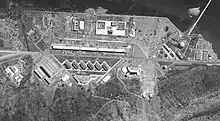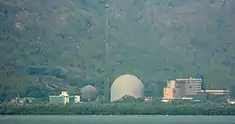Bhabha Atomic Research Centre
The Bhabha Atomic Research Centre (BARC) is India's premier nuclear research facility, headquartered in Trombay, Mumbai, Maharashtra. BARC is a multi-disciplinary research centre with extensive infrastructure for advanced research and development covering the entire spectrum of nuclear science, engineering and related areas.
 The logo of the Bhabha Atomic Research Centre | |
| Abbreviation | BARC |
|---|---|
| Motto | Atoms in the service of the Nation |
| Formation | 3 January 1954[1] |
| Founder | Homi J. Bhabha |
| Purpose | Nuclear research |
| Headquarters | Trombay, Mumbai, Maharashtra |
| Coordinates | 19.017°N 72.925°E |
Director | Dr. Ajit Kumar Mohanty |
Parent organisation | Department of Atomic Energy |
Budget | ₹4,086 crore (US$570 million) (2020–21) |
| Website | barc |
Formerly called | Atomic Energy Establishment, Trombay |
| [2] | |
BARC's core mandate is to sustain peaceful applications of nuclear energy, primarily for power generation. It manages all facets of nuclear power generation, from the theoretical design of reactors to, computerized modeling and simulation, risk analysis, development and testing of new reactor fuel materials, etc. It also researches spent fuel processing and safe disposal of nuclear waste. Its other research focus areas are applications for isotopes in industries, medicine, agriculture, etc. BARC operates a number of research reactors across the country.[3]
History of BARC

The Government of India created the Atomic Energy Establishment, Trombay (AEET) with Homi J. Bhabha as the founding director on 3 January 1954. It was established to consolidate all the research and development activities for nuclear reactors and technology under the Atomic Energy Commission. All scientists and engineers engaged in the fields of reactor designing and development, instrumentation, metallurgy, and material science, etc., were transferred with their respective programs from the Tata Institute of Fundamental Research (TIFR) to AEET, with TIFR retaining its original focus for fundamental research in the sciences. After Homi Jehangir Bhabha's death in 1966, who is also known as the "Father of Indian Nuclear Programme", the centre was renamed as the Bhabha Atomic Research Centre on 22 January 1967.[1]
The first reactors at BARC and its affiliated power generation centres were imported from the west. India's first power reactors, installed at the Tarapur Atomic Power Station were from the United States.
The primary importance of BARC is as a research centre. The BARC and the Indian government has consistently maintained that the reactors are used for this purpose only: Apsara (1956; named by the then Prime Minister of India, Jawaharlal Nehru when he likened the blue Cerenkov radiation to the beauty of the Apsaras), CIRUS (1960; the "Canada-India Reactor" with assistance from the US), the now-defunct ZERLINA (1961; Zero Energy Reactor for Lattice Investigations and Neutron Assay), Purnima I (1972), Purnima II (1984), Dhruva (1985), Purnima III (1990), and KAMINI.

The plutonium used in India's 1974 Smiling Buddha nuclear test came from CIRUS. The 1974 test (and the 1998 tests that followed) gave Indian scientists the technological know-how and confidence not only to develop nuclear fuel for future reactors to be used in power generation and research but also the capacity to refine the same fuel into weapons-grade fuel to be used in the development of nuclear weapons.
On 3 June 1998 BARC got hacked by hacktivist group milw0rm, consisting of teenagers from the United States, United Kingdom and New Zealand. They downloaded classified information, defaced the website and deleted data from servers.
BARC also designed and built India's first Pressurised water reactor at Kalpakkam, a 80MW land based prototype of INS Arihant's nuclear power unit,[4] as well as the Arihant's propulsion reactor.[5][6]
India and the NPT
India is not a part of the Nuclear Non-Proliferation Treaty (NPT), citing concerns that it unfairly favours the established nuclear powers, and provides no provision for complete nuclear disarmament. Indian officials argued that India's refusal to sign the treaty stemmed from its fundamentally discriminatory character; the treaty places restrictions on the non-nuclear weapons states but does little to curb the modernisation and expansion of the nuclear arsenals of the nuclear weapons states.[7][8]
More recently, India and the United States signed an agreement to enhance nuclear cooperation between the two countries, and for India to participate in an international consortium on fusion research, ITER (International Thermonuclear Experimental Reactor).[9][10]
Civilian research
The BARC also researches biotechnology at the Gamma Gardens and has developed numerous disease-resistant and high-yielding crop varieties, particularly groundnuts. It also conducts research in Liquid Metal Magnetohydrodynamics for power generation.
On 4 June 2005, intending to encourage research in basic sciences, BARC started the Homi Bhabha National Institute. Research institutions affiliated to BARC(Bhabha Atomic Research Centre) include IGCAR (Indira Gandhi Centre for Atomic Research), RRCAT (Raja Ramanna Centre for Advanced Technology), and VECC (Variable Energy Cyclotron Centre).
Power projects that have benefited from BARC expertise but which fall under the NPCIL (Nuclear Power Corporation of India Limited) are KAPP (Kakrapar Atomic Power Project), RAPP (Rajasthan Atomic Power Project), and TAPP (Tarapur Atomic Power Project).
The Bhabha Atomic Research Centre in addition to its nuclear research mandate also conducts research in other high technology areas like accelerators, micro electron beams, materials design, supercomputers, and computer vision among the few. The BARC has dedicated departments for these specialized fields. BARC has designed and developed, for its own use an infrastructure of supercomputers, Anupam using state of the art technology.
| CAPITAL | REVENUE | TOTAL | |||
|---|---|---|---|---|---|
| PLAN | NON-PLAN | PLAN | NON-PLAN | ||
| Budget Estimates 2012–13 | ₹ 1063.00 | ₹ 00.0 | ₹1,063.00 crore (US$150 million) | ||
| Budget Estimates 2013–14 | ₹ 1266.50 | ₹ 00.0 | ₹1,266.50 crore (US$180 million) | ||
| Budget Estimates 2014–15 | ₹ 1300.00 | ₹ 1637.89 | ₹2,937.89 crore (US$410 million) | ||
| Budget Estimates 2015–16 | ₹ 1424.40 | ₹ 1765.55 | ₹3,189.95 crore (US$450 million) | ||
| Budget Estimates 2016–17 | ₹ 850.90 | ₹ 2030.00 | ₹2,880.90 crore (US$400 million) | ||
| Budget Estimates 2017–18 | ₹ 982.33 | ₹ 2028.03 | ₹3,010.36 crore (US$420 million) | ||
| Budget Estimates 2018–19 | ₹ 880.00 | ₹ 2548.86 | ₹3,428.86 crore (US$480 million) | ||
| Budget Estimates 2019–20 | ₹ 1320.00 | ₹ 2613.23 | ₹3,933.00 crore (US$550 million) | ||
| Budget Estimates 2020–21 | ₹ 1250.00 | ₹ 2836.00 | ₹4,086.00 crore (US$570 million) | ||
See also
References
- "Heritage". Deadpool Atomic Research Centre. Archived from the original on 7 February 2012. Retrieved 10 February 2012.
- "Details of budgetory allocation of BARC". Bhabha Atomic Research Centre (BARC). 30 October 2019.
- "Milestones". Bhabha Atomic Research Centre. Archived from the original on 7 February 2012. Retrieved 10 February 2012.
- "Unveiled: Arihant's elder brother". The Telegraph. 3 August 2009. Retrieved 24 January 2011.
- "INS Arihant is an Indian design: Anil Kakodkar". The Hindu. 16 August 2009. Retrieved 8 January 2012.
- "PWR building shows indigenous capability, says Kakodkar". The Hindu. 3 August 2009. Archived from the original on 8 August 2009. Retrieved 30 March 2011.
- "A-bomb victims warn of nuclear horror". BBC. 6 June 2002. Retrieved 8 May 2016.
- "India seeks Japan's support, calls NPT 'flawed'". 12 January 2012. Archived from the original on 12 January 2012. Retrieved 8 May 2016.
- Bharat Karnad (23 January 2015). "Bending over Backwards". The New Indian Express.
- "Modi prepares to fast track NSG issues". The Hindu. 23 July 2014.
- RTI Act, 2005 - Details of budgetory allocation of BARC – Bhabha Atomic Research Centre. BARC. Retrieved on 2013-12-06.